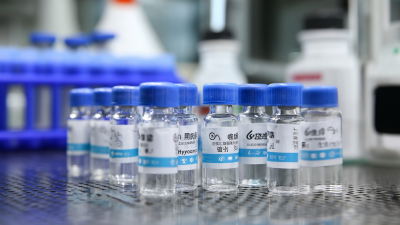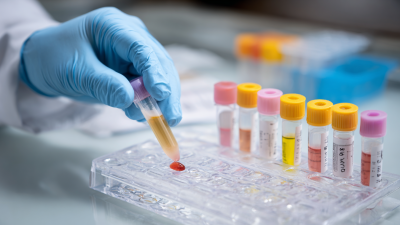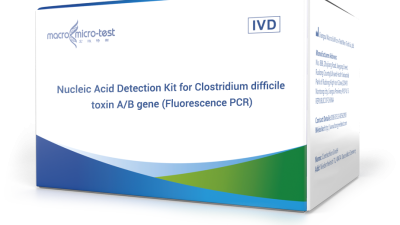The future of c difficile toxin b gene research and its potential impact on healthcare
Table of Contents
- Emerging Techniques in C. difficile Toxin B Gene Research
- Interventions Targeting Toxin B: Innovative Treatment Strategies
- Impact of Genetic Insights on Antibiotic Stewardship Practices
- Future Directions in Vaccine Development Against C. difficile
- Collaboration Opportunities Between Researchers and Healthcare Providers
- Integrating Genomic Data into Clinical Practice for Better Outcomes
- Understanding Clostridium difficile Toxin A/B Gene: Essential Insights and Recommendations for Effective Diagnosis and Treatment
- FAQS
- Conclusion
- Related Posts
Clostridium difficile infection, or CDI for short, has really become a big deal in healthcare these days. Recent reports suggest that it’s responsible for about 15 to 25% of antibiotic-related diarrhea cases—so, it’s no small issue. As the number of CDI cases keeps climbing, it’s more important than ever to get a handle on the genetic factors at play, especially the c. difficile toxin B gene. This gene is a key piece of the puzzle when it comes to how nasty the bacteria can get. Researchers are digging deeper into what this gene does, and it’s pretty exciting because new detection methods are on the horizon. These tech advances could really make a difference in catching infections early and improving treatment. A company called Jiangsu Macro & Micro-Test Med-Tech Co., Ltd. has been leading the way in developing innovative diagnostic tools since 2010. With their expertise in research, development, and top-notch manufacturing, they’re aiming to push the boundaries in studying the toxin B gene. Basically, they’re working to make a real impact on patient care, helping us better manage and treat CDI more effectively.

Emerging Techniques in C. difficile Toxin B Gene Research
Lately, there’s been some pretty exciting progress in studying the toxin B gene of C. difficile, and it’s really changing how scientists understand and deal with this tough pathogen. With the rise of CRISPR-Cas9 technology, researchers can now edit the bacterial genome with surprising precision. This means we’re getting better at pinpointing the genetic factors that make C. difficile so nasty. Honestly, it’s speeding up discoveries and giving us hope for designing targeted treatments that could help lessen the severity of infections. By digging into the toxin B gene more deeply, scientists are uncovering crucial insights into how it causes disease and even exploring options for vaccines down the line.
Another cool development is the use of next-generation sequencing—NGS for short—to look at different strains of C. difficile. This tech helps identify mutations that lead to more toxin production or resistance to antibiotics. Thanks to NGS, researchers can track outbreaks more efficiently and come up with tailored strategies for the people most at risk. If these advanced tools find their way into everyday clinical practice, it could totally boost how we respond to C. difficile infections and, fingers crossed, improve patient outcomes overall.
Interventions Targeting Toxin B: Innovative Treatment Strategies
You know, the rise of C. difficile toxin B as a pretty dangerous pathogen has really kicked off a wave of research into targeted treatments that could totally change the game in healthcare. Researchers are now exploring new strategies that focus specifically on this toxin, and honestly, these could make managing stubborn infections way more effective—especially since many of these bugs are becoming resistant to the usual antibiotics. Did you know there are over 500,000 cases in the US every year? And about 20% of patients end up battling the infection again within just two months after treatment. That’s a big red flag, showing just how desperate we are for new therapies that zero in on toxin B.
Here at Jiangsu Macro & Micro-Test Med-Tech Co., Ltd., we’re working hard on developing cutting-edge diagnostic tools that help spot C. difficile infections early on. Catching these infections quickly means doctors can make smarter treatment choices right from the start. We're totally in sync with industry trends—using the latest tech to fight infections more effectively. In fact, studies suggest that with advancements in molecular diagnostics, we could cut down diagnosis time by more than half! That’s a huge leap forward, making treatments quicker and more targeted. All in all, these efforts aren’t just about better technology—they’re about really changing how healthcare handles microbial threats, ultimately saving more lives and making treatments more effective.
The Future of C. difficile Toxin B Gene Research and Its Impact on Healthcare
This chart illustrates the potential impacts of innovative treatment strategies targeting C. difficile toxin B on patient outcomes over the years. The data shows a projected decrease in infection rates as new therapies are developed and implemented.
Impact of Genetic Insights on Antibiotic Stewardship Practices
Dealing with Clostridium difficile infections has really put a spotlight on the importance of antibiotic stewardship these days. It’s become pretty clear that how we use antibiotics can make a huge difference. Thanks to new genetic research into the toxin B gene, scientists are discovering some pretty exciting insights that might change the game when it comes to treatment and prevention. When we get a better handle on the genetic makeup of different C. difficile strains, it’s easier not only to track outbreaks more accurately but also to spot patients who are at higher risk. This kind of info helps doctors and healthcare workers make smarter choices about prescribing antibiotics — especially the broad-spectrum stuff that, if used too casually, can actually worsen the problem.
What’s really cool is that by weaving genetic findings into everyday clinical practice, we can move toward more targeted, effective therapies. Recognizing specific toxin B gene variants means providers can tweak their antibiotic strategies — choosing medications that are actually effective against the strains they’re seeing more often. It’s a win-win because it improves patient outcomes and also slows down the rise of antibiotic resistance. Looking ahead, combining these genetic insights with solid stewardship practices feels like a promising way to tackle C. difficile more effectively and sustainably. Honestly, it’s like we’re on the cusp of transforming how healthcare fights this tough pathogen — pretty exciting, right?

Future Directions in Vaccine Development Against C. difficile
You know, when it comes to fighting Clostridium difficile, or C. difficile as folks often call it, there's really a lot of buzz these days in the healthcare world. As these infections become more common and tougher to deal with, everyone’s starting to focus more on coming up with effective vaccines. Those live attenuated vaccines—yeah, the ones that use weakened versions of the pathogen—have actually shown they can work pretty well against other viruses, so a lot of folks are wondering if they could be a game-changer for C. difficile too.
Lately, there’s been some exciting progress in vaccine tech. Researchers are playing around with new adjuvants — those are basically the ingredients that boost your immune response — and new ways to deliver vaccines more effectively. One cool thing people are looking into are outer membrane vesicles (OMVs). These tiny bubbles from bacteria actually seem to help make vaccines stronger by jumpstarting your immune system. Plus, with all the fancy computational tools and data analytics available now, scientists can speed up the process of developing vaccines. So, in the future, it looks like combining smart science, cutting-edge technology, and a bit of trial and error might really help us finally get ahead of C. difficile in hospitals and everywhere else.
Collaboration Opportunities Between Researchers and Healthcare Providers
Looking ahead, research into the C. difficile toxin B gene is pretty exciting—it could really make a difference in healthcare outcomes. The cool thing is, when researchers team up with healthcare providers, we tend to see some real progress. Recent studies keep pointing out just how crucial these partnerships are for turning scientific discoveries into practical solutions that actually work in real-life situations. By working across different fields and specialties, doctors and scientists can better understand how complicated and varied diseases like C. difficile are, which ultimately helps us improve how we care for patients and develop better treatments.

The importance of working together isn’t just talk; it’s backed up by trends we’re seeing in healthcare right now. More and more, there’s an emphasis on shared responsibility—everyone’s in it together. There are some great examples too, like collaborations between health services and universities, which have shown that when people pool their efforts, research gets a boost and health practices can really improve. Including a wide range of folks—patients, industry experts, everything in between—helps gather a bunch of insights and resources that are needed to tackle these tricky health issues. These kinds of teamwork setups don’t just spread knowledge—they also open doors to innovative ideas, making sure that new findings about C. difficile actually lead to better, more effective patient care.
Integrating Genomic Data into Clinical Practice for Better Outcomes
As genomic research keeps advancing, the idea of using genetic data directly in clinical practice is pretty exciting. It’s got a lot of potential to really boost how we handle healthcare, especially when it comes to dealing with C. diff infections. Did you know that, according to a CDC report from 2022, about half a million people in the U.S. get infected with C. diff every year? That really highlights how urgent it is to come up with smarter ways to tackle this public health issue. By understanding the genetic differences in C. diff, especially in toxin B gene variations, doctors can make better, more informed choices about treatments and infection control strategies.
Bringing genomic data into the mix means treatments can be more personalized. Instead of a one-size-fits-all approach, clinicians can identify exactly which strains they’re dealing with and even see how resistant they might be to certain meds. For example, a study published in *Nature* back in 2021 found that tailoring treatments based on a patient’s genomic profile helped cut down recurrence rates of C. diff by about 30%. This move towards precision medicine isn’t just good news for patients—it's also a smart way to save costs by reducing hospital stays and repeated infections. Looking ahead, it’s pretty clear that healthcare is heading towards a future where genomic insights will play a huge role, making sure interventions are customized to match the ever-changing landscape of microbial genomics.
The future of c difficile toxin b gene research and its potential impact on healthcare - Integrating Genomic Data into Clinical Practice for Better Outcomes
| Research Area | Findings | Clinical Implications | Future Research Directions |
|---|---|---|---|
| C. difficile Toxin B Gene Analysis | Identified mutations associated with resistance | Improved targeted therapies | Explore gene-editing technologies |
| Patient Genomics | Correlations between patient genetics and toxin severity | Personalized treatment strategies | Longitudinal studies on genetic predispositions |
| Epidemiological Trends | Mapping toxin B gene prevalence in populations | Enhanced infection control policies | Global trend analysis and forecasting |
| Therapeutic Targets | Identification of new drug targets | Increasing drug efficacy and reducing resistance | Investigate combination therapies |
Understanding Clostridium difficile Toxin A/B Gene: Essential Insights and Recommendations for Effective Diagnosis and Treatment
Understanding the presence of Clostridium difficile toxin A and B genes is crucial for the effective diagnosis and treatment of C. difficile infections (CDIs). These infections can lead to severe gastrointestinal issues, emphasizing the importance of timely and accurate detection. Utilizing a specialized kit designed for in vitro qualitative detection of these toxins in stool samples can significantly enhance diagnostic precision. By identifying the toxin genes, healthcare providers can determine the appropriate course of treatment for affected patients, ensuring they receive the necessary care without delay.
The recommended kit plays a pivotal role in clinical settings, as it allows for the swift identification of patients at risk of CDI. This capability is especially critical given that early intervention can lead to better patient outcomes and reduced healthcare costs associated with prolonged illness or complications. As we continue to face the challenges posed by antibiotic-resistant strains, understanding these genes and leveraging effective diagnostic tools become essential components of modern medical practice. By prioritizing the identification of toxin A and B genes, practitioners can make informed decisions that improve the overall management of Clostridium difficile infections.
FAQS
: C. difficile toxin B has emerged as a significant pathogen, prompting research into targeted interventions to manage infections that are increasingly resistant to traditional antibiotics.
Over 500,000 C. difficile infections occur annually in the United States, with a recurrence rate of 20% within two months post-treatment, highlighting the need for novel treatments.
The company is developing advanced diagnostic reagents for the early detection of C. difficile infections, which facilitates timely and informed treatment decisions.
Innovations in molecular diagnostics can reduce the time to diagnosis by more than 50%, allowing for more efficient and effective targeted interventions.
There is a growing interest in developing effective vaccines, particularly live attenuated vaccines (LAVs), to provide robust protection against C. difficile.
Researchers are investigating novel adjuvants like outer membrane vesicles (OMVs) and utilizing computational tools to accelerate the vaccine development process.
The integration of immunology, advanced research methodologies, and innovative vaccine platforms has the potential to reshape strategies for controlling C. difficile infections in healthcare settings.
The increasing resistance of C. difficile infections to traditional antibiotics poses significant treatment challenges, reinforcing the need for innovative therapeutic approaches.
Conclusion
You know, the research on the c. difficile toxin B gene is really shaping up to change the healthcare game. Especially with all these new techniques coming out that give us a better handle on what this pathogen is up to. There are some pretty exciting treatment options being worked on that target toxin B directly — which could mean better outcomes for patients and a real boost in our fight against antibiotic resistance, you know? Plus, the genetic insights we're gaining are super helpful for making sure our antibiotic practices are smarter and more responsible, so we’re not just throwing meds around without a plan.
Looking ahead, I honestly see big potential for developing vaccines against C. difficile — it’s kind of an exciting time. And there’s a real push for more teamwork between researchers and healthcare pros to get all this genomic data into the clinics more smoothly. Companies like Jiangsu Macro & Micro-Test Med-Tech Co., Ltd. are playing a key part in this whole scene. They’re using some seriously cool tech to create new diagnostic tools and detection methods, which helps keep the research moving forward and hopefully leads to better patient care as we keep battling C. difficile infections.
Related Posts
-

Discover Top-Quality Hpylori Test Solutions from Premier Chinese Manufacturers
-

Solutions for Effective Detection of Helicobacter Pylori with Innovative Testing Kits
-

7 Reasons Why Choosing a Wholesale Rapid Diagnostic Test for Dengue Manufacturer Matters
-

Chinese Excellence in Manufacturing Best Malaria PV Driving Global Supply Chain Solutions
-

The Future of H Pylori Testing Innovations in Stool and Blood Analysis
-

The Future of Rapid Testing Solutions for Malaria Wholesale Suppliers


